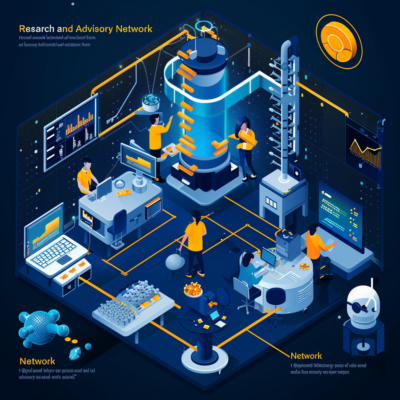
In this blog series, Jason Larson, content director at IIA, sits down with IIA experts who serve as sparring partners for Research and Advisory Network clients. IIA’s RAN expert community, with over 150 active practitioners and unbiased industry experts, is dedicated to advising data and analytics leaders on key challenges unique to their enterprise, including team organization, business value measurement, and user adoption.

Research and Advisory Network
Get access to the leading network of independent analytics expertise, allowing you to apply real practitioner insights against initiatives, projects, and problems.
In the rapidly evolving domain of enterprise data and analytics, the journey from technical expertise to effective leadership is both challenging and essential. Brad Schwartz, IIA expert and seasoned tech leadership coach and mentor, helps data and analytics leaders train their leadership muscles. With a focus on vertical growth, Schwartz guides leaders in shifting from mastering horizontal skills to developing the leadership qualities necessary for success in today's complex and fluid business environments.
In this conversation, we explore the concept of vertical growth, the hurdles that data and analytics leaders face, and the strategies for building trust, breaking down silos, and leveraging the power of AI. This discussion has been edited for length and clarity.
Brad, thanks for taking the time. You’ve helped our clients adopt frameworks and hone what you call their “vertical skills.” First, what do you mean by “horizontal” and “vertical” skills, and why is this shift to vertical growth so important for data and analytics leaders?
Brad Schwartz: Thanks, I’m looking forward to the talk. One of the things I discovered in my own career growth as an enterprise analytics leader and working with a lot of D&A leaders across all industries, is that many of us in the technical domain got to where we are based on our focus on growing our horizontal skills. What I mean by that is mastering the tools and tech, the project management skills, the implementation of agile methodologies and other analytical methods and practices—those types of competencies. But what got us here is not going to take us where we need to be. Our skills start to shift as we move up in our careers, and we often haven't taken as much time to invest in growing the vertical skills.
These vertical skills include communication, influence, collaboration, and other leadership skills. As you grow as a data and analytics leader, collaboration becomes less about within your team and more about across teams. Your influence expands to your business stakeholders. It's learning to have difficult conversations, like having what I call “straight talk” conversations with business partners around the excitement about AI and the importance of the data foundation. How do you achieve both business outcomes and the necessary business process work? These are the messy programmatic and human hurdles leaders must overcome using their vertical skills. Beyond my anecdotal experience as an analytics leader and coach and mentor to my peers, the research is overwhelming that these skills can be learned.
The data says only 20% of teams are high performing. Most of us have been on high-performing teams and dysfunctional teams alike. We know the difference between the two. There are frameworks, guideposts, proven methods that help leaders practice these vertical skills. We can and should make the same investment in our vertical skills as horizontal skills.
Ok, so if we distilled this into the most common challenges data and analytics leaders face in achieving vertical growth what would those challenges be?
Brad Schwartz: One of the biggest challenges is cross-functional collaboration. In a siloed environment—which is very common in non-digital native enterprises in the throes of digital transformation—breaking down those silos and building trust can be difficult. This ties to the challenge of effectively influencing without authority, which of course depends on reporting lines and how the D&A organization is maturing—and viewed—within an enterprise.
Within teams, a big challenge is learning to ask more questions and tell less. As leaders, we need to empower and enable our teams by guiding them toward their own solutions, even if we know the answer. As a leader, you need to create the conditions for high-performance. How are you creating the conditions for camaraderie and a shared vision? How are you developing trust and clarity around roles and responsibilities?
Communication is another big challenge. Upleveling communication for management, understanding what business stakeholders care about, connecting the dots back to business value, empowering members within your team are all important aspects of vertical growth.
Going back to upleveling communication for management, this is a struggle for many who built their careers on technical expertise. What do your business partners really need to know? Again, this requires an understanding of what they care about. There is a very good chance the one thing they don’t care about is the technology. They want to know what they can do with it. It’s the responsibility of the leader to communicate that effectively.
These challenges resonate with the peer-to-peer discussions we facilitate and the strategic guidance we offer to D&A leaders and key members of their teams. So, where does one begin? How does one get started on this work? This journey is deeply personal and, forgive the term, “soft.”
Brad Schwartz: Sure, we’re talking about soft skills here, but I like to think of them as “human skills.” Forgive the cliché, but the softest parts of the job are often the hardest parts of the job.
The reality is that, as a leader, we need to decide where to focus. That’s actually the biggest challenge for most people. And whether you’ve invested in a leadership coach or doing this work yourself, this journey must start with: Where am I at right now? What are my strengths? Weaknesses? Values? What type of feedback have I received so that I can reflect on my self-identity but also my reputation? I can’t overstate the importance of spending time with questions that help you explore your self-awareness, which in turn impacts your self-identity, and ability to reflect on your reputation.
Once you’ve explored these types of questions, then you can focus your attention on where you want to go. If someone is doing this hard work they of course want to grow personally and professionally, but how, exactly, do they want to evolve as a leader? What type of leader do they want to be? Frameworks can help here, but you’re basically picking straws out of a hat if you don’t understand where you are and where you want to go.
If self-awareness is your starting point, then you can identify and develop new behaviors. And while the conceptual part of this journey is important, true growth is all about practice, feedback, reflection. Then, rinse and repeat. The actual growth is in the practice and adjustments based on feedback and reflection. There’s no shortcut to changing behavior.
What are the outcomes you see when leaders grow their vertical skills?
Brad Schwartz: If, for example, my stakeholders want to better predict sales, this business desire requires a solid data foundation. Communicating this requirement likely means I need to have a “straight talk” conversation with business stakeholders about the state of the company’s data foundation and what resources are needed to build up to better predictive models. In this situation, I have to clearly and effectively set expectations—and be a good business partner in the process. Most importantly, I’m not just laying out the technology or talent requirements, but the business outcomes we're trying to achieve together—and that is a significant shift in tone, purpose, and substance.
Successfully discussing trade-offs is another good one. This ties to building trust with stakeholders and intentionally building your business relationships over time so you can have candid conversations. If we're facing a deadline, we might need to discuss trading off some scope to ensure we're delivering value, not just insights.
In my experience, the D&A org can deliver great things, but if our customers don't leverage our products, how successful can we say we’ve been? It's not just about delivering insights. It's about our data customers adopting and acting on those insights.
This concept of “building trust” is so important and yet many discussions I see on the topic feel generic or too theoretical. Practically speaking, how can data and analytics leaders build trust and break down silos within their organizations?
Brad Schwartz: I know what you mean, and I’ve spent a lot of time thinking about how to make this trust equation as concrete as possible. First, you have to find shared objectives by understanding what results your business stakeholders are trying to achieve and finding commonality around that. That’s step one.
Once you understand what motivates your stakeholders, bring curiosity to the equation. What are they seeing differently? What are they excited about? What will bring them success? Align your objectives with theirs to reduce clashes.
If you encounter resistance or embedded conflicts, bring those to the surface and work through them. When leaders don’t have the vertical skills to confront these conflicts head on, people end up working around each other, which exacerbates the silo effect. Also, use frameworks like Stephen Covey's circle of influence to focus on what you can control and influence, and don't waste energy on things outside your control. Try not to boil the ocean.
We’ve been discussing some smart, timeless leadership principles. How do you see the data and analytics leadership role evolving and how will this impact the vertical skills leaders should adopt over the next, say, three to five years.
Brad Schwartz: In a sense, what you’re really asking is how do we see the role of AI impact the evolution of D&A leadership. AI, especially generative AI, is a huge disruptor. There’s no debate about that. Yes, there's a lot of hype we need to sift through, but it's also a real disruptor. One recent study predicts that 40% of job roles will be restructured by 2027 due to AI. As leaders, we need to think about how skills will change in our organizations and how we can take advantage of this shift.
With AI, there will be productivity benefits, which means our teams can do higher-value work. This higher-value work will require more human skills, like business conversation, collaboration, and trust-building. We need to let machines do what they can but focus on the opportunities AI presents for human skills development.
As leaders, we can scale up our teams and have the right conversations with our business stakeholders about the possibilities and changes AI brings. This goes back to communication, influence, collaboration, and building trust for constructive conversations.
On that note, take us home. What are some key takeaways or advice you would offer to data and analytics leaders looking to grow vertically?
Brad Schwartz: AI is going to disrupt all of us. As leaders, we have a core responsibility to harness that value, which requires us invest in our vertical skills. Getting comfortable having hard conversations is key for achieving value.
We’ve all seen the X-percent of AI projects fail stats. Whether it’s 70% or 80%, the point is a large percentage of transformation programs fail, but we know the reasons. We often mitigate them with methodologies and customer adoption strategies, but what work are we doing to build the high-performing team we need? Creating an environment that supports our team members is crucial.
It all starts with trust, supporting a level of conflict, accountability, and holding each other accountable. How do we execute within our sphere of control and influence, deliver value, and not fall victim to things we can't control?